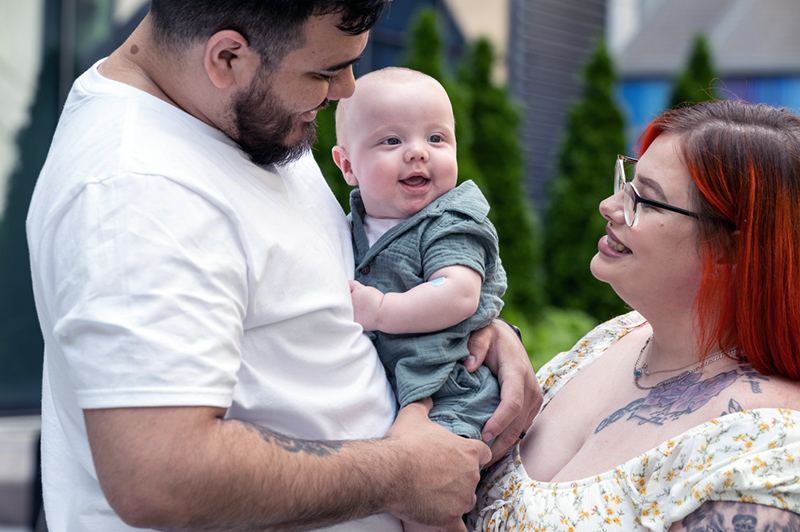Beyond expectations: Treating Isaac’s teratoma through an EXIT procedure

Jennifer worked as a hairdresser until just days before delivering her son, Isaac, last December, even though she had planned to stop a week earlier. Beating expectations must run in the family because Isaac has been doing just that since before he was even born. He has amazed everyone around him with how well he has defied projections after doctors discovered a mass on his neck in utero that they feared could comprise his airway upon delivery.
“He’s a miracle,” his father, Angel, says.
Finding a strategy
Jennifer’s OB-GYN in Western Massachusetts discovered the mass at 27 weeks during a prenatal ultrasound. When a follow-up scan a few weeks later determined the mass had grown, Jennifer was referred to the Maternal Fetal Care Center (MFCC),in affiliation with Brigham and Women’s Hospital. There, an MRI and other tests confirmed that it was a teratoma, a type of tumor that contains different forms of tissue.
While most teratomas are benign (non-cancerous), they often grow rapidly. For Isaac, the more the teratoma grew, the more it pressed on his airway. The MFCC ’s concern was that the teratoma would block his airway once he was out of the womb and trying to breathe on his own.
“The team wanted to make sure he had a stable airway during delivery,” Jennifer says. “They wanted to make sure he had the best chance.”
Giving Isaac the best chance meant stabilizing his airway before he took his first breath. To do this, the MFCC team planned an ex-utero intrapartum treatment (EXIT), which involves partially delivering a baby via cesarean delivery while keeping it connected to the umbilical cord and placenta. The procedure allows the medical team time to treat and secure the obstructed airway so that when the umbilical cord is cut, the baby can breathe on its own. EXIT procedures are typically scheduled between 35 and 37 weeks of pregnancy to reduce the risk of prematurity complications or the need for an emergency cesarean delivery.
“We knew this was the best option,” says Jennifer.
Working toward a common goal
Jennifer was closely monitored for signs of premature labor or indications that Isaac might arrive early on his own. She and Angel traveled weekly to Boston Children’s for ultrasounds to assess the teratoma’s growth and to meet with their extensive care team. This team included fetal surgeons, pediatric and otolaryngology surgeons, newborn medicine specialists, nurses, social workers, and other experts. Each team member spoke with Jennifer and Angel to outline their role in ensuring a safe delivery for both Isaac and Jennifer and the comprehensive treatment plan after Isaac’s arrival.
Dr. Alireza Shamshirsaz (Shami), fetal surgeon and director of the MFCC, explained how the EXIT procedure would work: He would perform the cesarean delivery and stabilize Isaac while he was still attached to the placenta. At the same time, Dr. Reza Rahbar, Dr. Terry Buchmiller, and other surgical team members would stabilize Isaac’s airway. Dr. Buchmiller described how she and Dr. Rahbar’s team would remove the tumor a few days after delivery and explained the extensive surveillance Isaac would need to ensure the tumor did not come back. Neonatologist Dr. Philip Levy outlined the roadmap for getting Isaac home, emphasizing benchmarks such as independent eating and breathing, growth, and hitting developmental milestones.
Jennifer and Angel appreciate the thoroughness, honesty, and compassion every team member showed them, especially social worker Kassie Merrill-Olver and registered nurse Olivia Oppel, who guided them through each meeting, appointment, and step of their journey.
“They treated us really well,” says Angel. “They were so good about preparing us for the procedure and for what it could look like for Isaac after.”
Knocking down expectations
On December 6 — when Jennifer was 35 weeks — the team assembled at Boston Children’s to perform the EXIT procedure. More than 65 clinicians and support staff took up two operating rooms to ensure that Isaac and Jennifer each had the care they needed. Kassie sat with Angel for support.
Working together, the team accessed and secured Isaac’s airway and completed his delivery in almost half the time they projected. Two days later, Drs. Buchmiller and Rahbar were able to remove the teratoma from Isaac’s neck. After two weeks in the neonatal intensive care unit (NICU), Isaac was eating and breathing on his own and strong enough to go home — a far cry from the extended stay Jennifer and Angel had braced for.
Eight months later, Isaac is thriving. He continues to see Dr. Buchmiller, who monitors for any signs the teratoma is regrowing, and Dr. Rahbar, who monitors how his throat and vocal cords are developing post-surgery. Overall, though, Isaac’s happy, healthy, and boisterous.
“He’s the easiest baby ever,” Jennifer says. “He’s definitely starting to use those vocal cords, that’s for sure.”
Learn more about the Maternal Fetal Care Center.
Related Posts :
-

Rowan the Remarkable: Defying the odds with CPAM
This is the story of a baby named Rowan and his remarkable journey of beating the odds after doctors discovered ...
-

Finding comfort and answers for twin-twin transfusion syndrome: Shannon’s story
Shannon’s journey through a challenging pregnancy with TTTS (twin-twin transfusion syndrome) was, as she puts it, an emotional rollercoaster. ...
-

Changing the world: Baby Denver leads the way after first-of-its-kind procedure for VOGM
Denver Coleman is less than 2 months old, but she’s already helped blaze a trail for other children and families, ...
-

A partner through amniotic band syndrome: Jace’s story
Jace is a happy, energetic 9-month-old whose big brown eyes light up a room. He’s adored by his parents, ...





